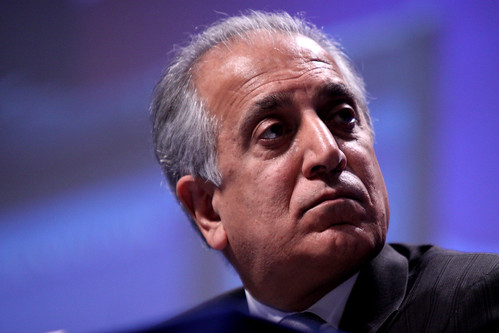 CC Image Courtesy of Gage Skidmore on Flickr
CC Image Courtesy of Gage Skidmore on Flickr
US Taliban Peace Talks: Where Are We Now?
An attack by the Taliban earlier this month was responsible for the death of two United States service members, marking the first US deaths in Afghanistan this year. US sentiments appeared to be optimistic after the Taliban offered a 10-day ceasefire with US forces and a “reduction in violence” with the Afghan government. However, the relaunched negotiations have resulted into little progress toward a peace agreement.
The peace process has endured multiple disruptions. At the end of 2019, negotiations were in a grim position when a Taliban attack on Bagram Airfield sparked outrage by US officials, including US Special Representative for Afghanistan Reconciliation Zalmay Khalilzad:
“When I met the Talibs today, I expressed outrage about yesterday’s attack on Bagram, which recklessly killed two and wounded dozens of civilians. #Taliban must show they are willing & able to respond to Afghan desire for peace.”
Amid stalled peace talks, the Taliban was the first to approach Khalilzad with the offer of a temporary ceasefire. The past year saw the US drop a record number of bombs on Afghanistan. The hope was this ramped up level of violence would pressure the Taliban to offer more concessions. However, it is unlikely that the Taliban is only showing an eagerness to initiate peace talks and the US withdrawal of troops based on heightened violence. Laurel Miller, former US acting special representative for Afghanistan and Pakistan, explains that this strategy did little to give the US leverage and only increased the number of civilian deaths. She states,
“The argument that is made in favor what they’re doing is that this will somehow change the political dynamics and in a way that makes the Taliban more likely to come to favorable terms at the peace table, but I have no expectation that this is going to have that kind of effect.”
Rather, the Taliban’s newfound flexibility around a temporary ceasefire is an attempt to appease the US in order to continue talks without the Kabul government. By excluding the demands of the Afghan government, the militant group is more likely to secure a swift US withdrawal.
The Afghan government has been largely excluded from discussions with the militant group, which views the government as “US puppets.” President Ashraf Ghani has been very vocal about his fears of a premature departure of US troops that could sever pivotal support for the struggling Afghan forces. A close official in the Kabul administration noted that Ghani was ready for a further reduction of 4,000 American troops, one-third of those remaining, to ease Trump’s concerns about the cost of US presence in Afghanistan.
Despite his exclusion, Ghani’s concerns have not gone unheard. The withdrawal of US troops is a major obstacle facing the US-Taliban talks. The Taliban refuse to negotiate a ceasefire with the Afghan government until the US formally withdraws from the region. This presents several commitment problems for the US and Afghan government.
- The Afghan government is excluded from the initial agreement, prompting questions about the US’s dedication to Afghanistan’s interests.
- Without US enforcement, there are no mechanisms that guarantee the Taliban will negotiate with the Afghan government instead of using the US withdrawal to take advantage of Kabul’s forces.
As a result of the hurdles facing negotiations, the office of Afghanistan’s president has demanded that the Taliban agree to a complete ceasefire and described the announced “reduction in violence” as inadequate. The US has also shared speculation about the Taliban’s “reduction in violence” and commitment to negotiate a larger scale ceasefire at a “later stage.” In a commentary published last Thursday on their website, the Taliban accused Washington of “wasting time” and said the talks with Khalilzad had become bogged down over a definition for the “reduction of violence.” Despite the initial optimism, the peace talks face yet another pause unless the Taliban offers further concessions.
Violence between the Taliban and Afghan government has raged on, showing little assurances about any commitment to a “reduction in violence.” On Sunday, 7 civilians, including 3 children, were killed in Afghan government air raids that were targeting Taliban forces. In response, the Taliban killed 13 Afghan security forces in the northern Kunduz province Wednesday morning. Although US officials and the Taliban want the same thing —to withdraw US troops— the Afghan government must officially be included in the agreement or the conflict will continue to worsen and further stall peace talks.





